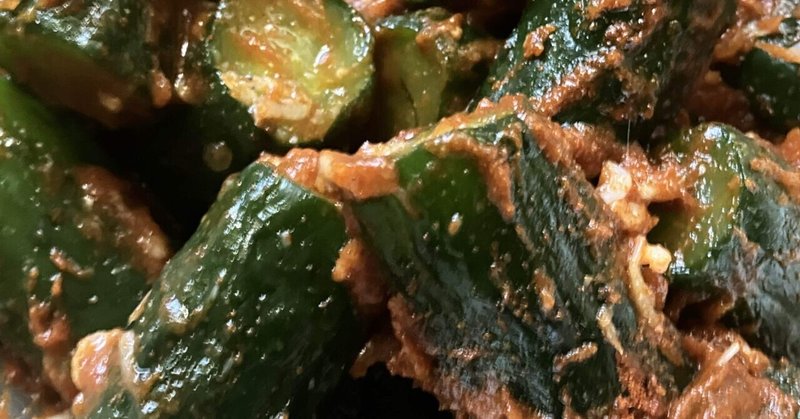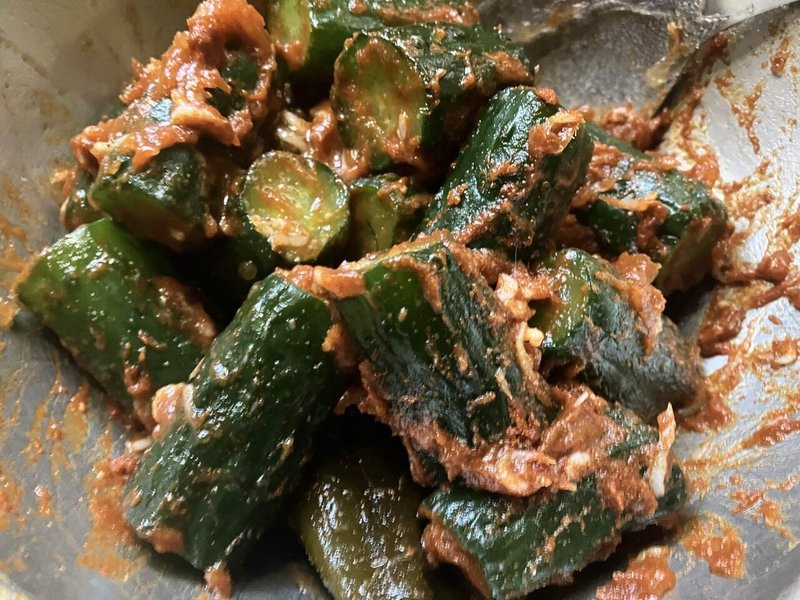
オイキムチ(胡瓜のキムチ) Oi kimchi /Cucumber kimchi
焼肉屋さんのレシピ集
Yakiniku restaurant recipe collection
ストーリー
Recipe trivia
以前、焼肉屋さんに提供したレシピから家庭でも作りやすいものを拾いました。手抜きしない無添加のプロでも使えるレシピです。
I picked up some recipes from a yakiniku restaurant I once provided that are relatively easy to make at home. They are additive-free recipes that even professionals can use without cutting corners.
春になって、早生の胡瓜がこなれた値段になって来たので、胡瓜のキムチを作りました。
オイは韓国語で胡瓜のこと。日本の焼肉屋では、白菜のキムチ、大根のキムチと並んで人気がある三大キムチの一つです。作り易く、白菜や大根のキムチよりさっぱりしているので、キムチがあまり得意でない人にも日本では人気があります。
Now that spring has come and early cucumbers have become more affordable, I made cucumber kimchi. Oi means cucumber in Korean. At Japanese yakiniku restaurants, it is one of the three most popular kimchis, along with Chinese cabbage kimchi and radish kimchi. It is easy to make and has a lighter taste than chinese cabbage or radish kimchi, so it is popular in Japan even among people who are not very fond of kimchi.
Tips and tricks:
コツと応用のヒント:
作り方は以前紹介した白菜のキムチと基本的には同じですので、そちらをご参照ください。白菜を塩漬けする一口大にカットした胡瓜を使います。
本場の朝鮮半島では、ニラなど香味野菜を一緒に漬け込むことが多いのですが、ここでは、シンプルに胡瓜だけを漬け込んでいます。香味野菜を使う場合は、胡瓜を下漬けする時に切れ込みを入れておきます。そして、ニラ、ニンジン、大根などを千切りして、軽く塩を振ってから揉み、胡瓜の間に挟んで本漬けをします。
作り立てでも生キムチとしてさっぱり食べることができます。その後は冷蔵庫のチルド室などで管理すれば、じっくり熟成が進み良い常備菜となります。熟成して酸味が出た頃が一番の食べ頃。その後熟成して酸味が強くなっていきますが、僕はそういう古漬けが好物です。苦手な人は、鍋やビビンパ、クッパなどに使って食べ切ってしまいましょう。
The method of preparation is basically the same as the cabbage kimchi introduced previously, so please refer to that. Instead of salting cabbage, bite-sized pieces of cucumber are used.
Here, powdered kelp is used instead of shredded kelp so that you can enjoy the texture of the cucumber.
In the original Korean peninsula, it is common to pickle aromatic vegetables such as chives together, but here, we simply pickle only the cucumber. If aromatic vegetables are used, make cuts in the cucumber when pre-pickling it. Then, cut the chives, carrots, radish, etc. into thin strips, sprinkle a light amount of salt on them, rub them, and then sandwich them between the cucumber during the main pickling process.You can eat it fresh as raw kimchi. If you store it in the chilled compartment of the refrigerator after that, it will slowly mature and become a good staple dish. It is best eaten when it has matured and has become sour. It will become more sour as it matures, but I like old kimchi like that. If you don't like it, you can eat it all up by using it in hotpot, bibimbap, soup, etc.







キムチの熟成は零度付近が適しているのでチルド室を使うと寒い朝鮮半島の味を出すことができます。キムチが大好きで場所に余裕があるなら、キムチ冷蔵庫を買ってしまうのも手です。本来のキムチ作りの季節の気候を再現してくれるので、いつでも上手にキムチが作れます。キムチに限らず、ザワークラウトや日本や中国の漬物も寒い季節に作るものですから、漬物好きや小さなレストランなら一考に値します。
Kimchi is best aged around zero degrees, so using the chilled compartment will help you get the taste of the cold Korean Peninsula. If you love kimchi and have the space, buying a kimchi refrigerator is a good idea. It recreates the climate of the original kimchi-making season, so you can make good kimchi anytime. Not only kimchi, but sauerkraut and Japanese and chinese pickles are also made in the cold season, so it's worth considering if you're a pickle lover or have a small restaurant.
Guide to where to get ingredients and equipment 材料と機材の入手先ガイド
この記事が気に入ったらサポートをしてみませんか?
